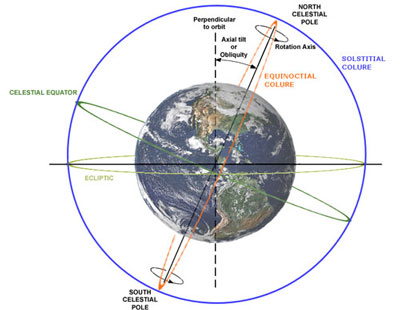Is The Direction That Earth's Axis Is Tilted Changing As Earth Orbits The Sun

Today's equinox signals the change of season, from summer to fall in the Northern Hemisphere and in the Southern Hemisphere from wintertime to spring. Simply why do Earth'southward seasons change?
September equinox: All you lot demand to know
Some assume our planet'due south irresolute distance from the lord's day causes the change in the seasons. That'southward logical, but not the example for Earth. Instead, Earth has seasons because our planet's axis of rotation is tilted at an angle of 23.5 degrees relative to our orbital plane, that is, the plane of Earth's orbit effectually the sun.
The tilt in the axis of the Earth is called its obliquity by scientists.

Over the course of a year, the angle of tilt does not vary. In other words, Globe's northern axis is e'er pointing the same direction in infinite. At this time, that direction is more or less toward the star we call Polaris, the Due north Star. Just the orientation of Earth'due south tilt with respect to the dominicus – our source of low-cal and warmth – does change as we orbit the sun. In other words, the Northern Hemisphere is oriented toward the sun for half of the twelvemonth and abroad from the sun for the other half. The same is true of the Southern Hemisphere.
When the Northern Hemisphere is oriented toward the lord's day, that region of Earth warms because of the respective increase in solar radiation. The sun's rays are hit that part of Globe at a more direct angle. It's summer.
When the Northern Hemisphere is oriented abroad from the sun, the sun'southward rays are less direct, and that function of World cools. It's wintertime.
Seasons in the Southern Hemisphere occur at opposite times of the year from those in the Northern Hemisphere. Northern summer = southern winter.

The tilt in Earth's axis is strongly influenced by the way mass is distributed over the planet. Large amounts of country mass and ice sheets in the Northern Hemisphere brand Earth acme-heavy. An illustration for obliquity is imagining what would happen if you were to spin a brawl with a piece of bubble gum stuck near the pinnacle. The actress weight would cause the ball to tilt when spun.
Over long periods of geological fourth dimension, the bending of World's obliquity cycles between 21.1 and 24.5 degrees. This cycle lasts approximately 41,000 years and is idea to play a primal role in the formation of ice ages – a scientific theory proposed by Milutin Milankovitch in 1930.
The Globe is currently decreasing in obliquity. Decreases in obliquity tin set the stage for more moderate seasons (cooler summers and warmer winters) while increases in obliquity create more extreme seasons (hotter summers and colder winters). Glaciers tend to grow when the Earth has many cool summers that fail to melt back the wintertime snows. Remember, we're talking near a 41,000-year bicycle hither, so these changes in obliquity are not the chief driver of Earth'southward climate in the century ahead. Temperatures on Earth are influenced not just by obliquity, but also by many more factors which bulldoze our complex climate organization and the global temperatures we feel from year to twelvemonth.
Other planets in our solar system also tilt at various degrees. Uranus rotates almost sideways at 97 degrees and has extreme seasons. The axial tilt on Venus is 177.3 degrees. Hence, Venus has very piddling in the fashion of seasons.
Earth's distance from the dominicus does change throughout the year, and information technology's logical to assume that an increase or decrease in a lord's day-planet distance could cause a cyclical alter in the seasons. But – in the instance of our planet – this change is too small to cause this change.
Our seasons change due to our planet'due south angle of tilt – 23.5 degrees – relative to our orbit effectually the sunday. If Earth did not tilt at all, but instead orbited exactly upright with respect to our orbit around the sun, at that place would exist pocket-size variations in temperature throughout each year as Earth moved slightly closer to the sun and then slightly farther away. And there would be temperature differences from Earth's equatorial region to the poles. Just, without Earth's tilt, we'd lack Earth'southward wonderful seasonal changes and our association of them with the various times of yr – associating a fresh feeling in the air with springtime, for example.
It'southward easy to imagine a planet that has a more pronounced modify in its distance from its star equally the planet orbits the star. Some extrasolar planets – planets orbiting afar stars – have been constitute with more farthermost orbits. And even in our own solar system, for example, the planet Mars has a more elliptical orbit than Earth does. Its distance from the lord's day changes more dramatically through its year than Earth'southward does, and the change in Mars' distance from the sun does crusade some more pronounced cyclical changes on this red desert earth.

Bottom line: It's logical to presume our planet'southward irresolute altitude from the lord's day causes the change in the seasons. Merely Earth's altitude from the sun doesn't change plenty to crusade seasonal differences. Instead, our seasons change because Earth tilts on its centrality, and the angle of tilt causes the Northern and Southern Hemispheres to merchandise places throughout the year in receiving the sunday's low-cal and warmth most directly.
Source: https://earthsky.org/earth/can-you-explain-why-earth-has-four-seasons/
Posted by: wilsonmarmyre.blogspot.com


0 Response to "Is The Direction That Earth's Axis Is Tilted Changing As Earth Orbits The Sun"
Post a Comment